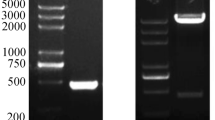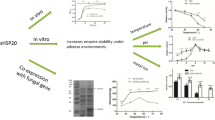Abstract
The present study reports the recognition and characterization of the gene encoding the co-chaperone DnaJ in the halophilic strain Mesobacillus persicus B48. The new extracted gene was sequenced and cloned in E. coli, followed by protein purification using a C-terminal His-tag. The stability and function of the recombinant DnaJ protein under salt and pH stress conditions were evaluated. SDS-PAGE revealed a band on nearly 40-kDa region. The homology model structure of new DnaJ demonstrated 56% similarity to the same protein from Streptococcus pneumonia. Fluorescence spectra indicated several hydrophobic residues located on the protein surface, which is consistent with the misfolded polypeptide recognition function of DnaJ. Spectroscopic results showed 56% higher carbonic anhydrase activity in the presence of the recombinant DnaJ homolog compared to its absence. In addition, salt resistance experiments showed that the survival of recombinant E. coli+DnaJ was 2.1 times more than control cells in 0.5 M NaCl. Furthermore, the number of recombinant E. coli BL21+DnaJ colonies was 7.7 times that of the control colonies in pH 8.5. Based on the results, DnaJ from the M. persicus can potentially be employed for improving the functional features of enzymes and other proteins in various applications.










Similar content being viewed by others

Data availability
The authors confirm that all relevant data are included in this article.
References
Booth IR (1985) Regulation of cytoplasmic pH in bacteria. Microbiol Rev 49(4):359–378
Bracher A, Verghese J (2015) The nucleotide exchange factors of Hsp70 molecular chaperones. Front Mol Biosci 2:10
Bukau B, Horwich AL (1998) The Hsp70 and Hsp60 chaperone machines. Cell 92(3):351–366
Caplan AJ, Cyr DM, Douglas M (1993) Eukaryotic homologues of Escherichia coli dnaJ: a diverse protein family that functions with hsp70 stress proteins. Mol Biol Cell 4(6):555–563
Carrió MM, Villaverde A (2001) Protein aggregation as bacterial inclusion bodies is reversible. FEBS Lett 489(1):29–33
Cheetham ME, Caplan AJ (1998) Structure, function and evolution of DnaJ: conservation and adaptation of chaperone function. Cell Stress Chaperones 2(1):28
Consortium SG (2008) Protein production and purification. Nat Methods 5(2):135
Emami A, Ghafouri H, Sariri R (2023) Polyphyllin D-loaded solid lipid nanoparticles for breast cancer: synthesis, characterization, in vitro, and in vivo studies. Int J Pharm 639:122976
Fan C-Y, Lee S, Cyr DM (2003) Mechanisms for regulation of Hsp70 function by Hsp40. Cell Stress Chaperones 8(4):309
Fan C-Y et al (2005) The type I Hsp40 zinc finger-like region is required for Hsp70 to capture non-native polypeptides from Ydj1. J Biol Chem 280(1):695–702
Foster JW, Hall HK (1991) Inducible pH homeostasis and the acid tolerance response of Salmonella typhimurium. J Bacteriol 173(16):5129–5135
Ghafoori H, Askari M, Sarikhan S (2017) Molecular cloning, expression and functional characterization of the 40-kDa heat shock protein, DnaJ, from Bacillus halodurans. Process Biochem 54:33–40
Greene MK, Maskos K, Landry SJ (1998) Role of the J-domain in the cooperation of Hsp40 with Hsp70. Proc Natl Acad Sci 95(11):6108–6113
Hall H, Karem K, Foster J (1995) Molecular responses of microbes to environmental pH stress. Adv Microb Physiol 37:229–272
Hasegawa T et al (2018) DnaJ/Hsp40 family and Parkinson’s disease. Front NeuroSci 11:743
Hennessy F et al (2000) Analysis of the levels of conservation of the J domain among the various types of DnaJ-like proteins. Cell stress & chaperones 5(4):347
Hickey EW, Hirshfield IN (1990) Low-pH-induced effects on patterns of protein synthesis and on internal pH in Escherichia coli and Salmonella typhimurium. Appl Environ Microbiol 56(4):1038–1045
Jahangirizadeh Z et al (2018) Molecular cloning, prokaryotic expression, purification, structural studies and functional implications of heat shock protein 70 (Hsp70) from Rutilus frisii kutum. Int J Biol Macromol 108:798–807
Jahangirizadeh Z et al (2020) Rapid and simple screening of the apoptotic compounds based on Hsp70 inhibition using luciferase as an intracellular reporter. Anal Bioanal Chem 412(1):149–158
Jhamb K, Jawed A, Sahoo DK (2008) Immobilized chaperones: a productive alternative to refolding of bacterial inclusion body proteins. Process Biochem 43(6):587–597
Johnston CL et al (2018) Using single-molecule approaches to understand the molecular mechanisms of heat-shock protein chaperone function. J Mol Biol 430(22):4525–4546
Kanbar B, Ozdemir E (2010) Thermal stability of carbonic anhydrase immobilized within polyurethane foam. Biotechnol Prog 26(5):1474–1480
Krulwich TA, Sachs G, Padan E (2011) Molecular aspects of bacterial pH sensing and homeostasis. Nat Rev Microbiol 9(5):330–343
Lico C, Chen Q, Santi L (2008) Viral vectors for production of recombinant proteins in plants. J Cell Physiol 216(2):366–377
Lotfi M et al (2021) Cloning, prokaryotic expression, and functional characterization of a novel 70-kDa heat shock protein (DnaK) from Bacillus persicus. Process Biochem 102:122–131
Martin J, Hartl FU (1997) Chaperone-assisted protein folding. Curr Opin Struct Biol 7(1):41–52
Matulis D, Lovrien R (1998) 1-Anilino-8-naphthalene sulfonate anion-protein binding depends primarily on ion pair formation. Biophys J 74(1):422–429
Matulis D, et al. (1999) 1-Anilino-8-naphthalene sulfonate as a protein conformational tightening agent. Biopolymers: Original Res Biomol 49(6):451–458
Mitra A, Shevde LA, Samant RS (2009) Multi-faceted role of HSP40 in cancer. Clin Exp Metastasis 26(6):559–567
Mosaddegh B et al (2018) An inter-subunit disulfide bond of artemin acts as a redox switch for its chaperone-like activity. Cell Stress Chaperones 23(4):685–693
Parihar P et al (2015) Effect of salinity stress on plants and its tolerance strategies: a review. Environ Sci Pollut Res 22(6):4056–4075
Pauli D, Arrigo A-P, Tissières A (1992) Heat shock response in Drosophila. Experientia 48(7):623–629
Qiu X-B et al (2006) The diversity of the DnaJ/Hsp40 family, the crucial partners for Hsp70 chaperones. Cell Mol Life Sci CMLS 63(22):2560–2570
Requena JM, Montalvo AM, Fraga J (2015) Molecular chaperones of Leishmania: central players in many stress-related and-unrelated physiological processes. BioMed Res Int. https://doi.org/10.1155/2015/301326
Richter K, Haslbeck M, Buchner J (2010) The heat shock response: life on the verge of death. Mol Cell 40(2):253–266
Rosano GL, Ceccarelli EA (2014) Recombinant protein expression in Escherichia coli: advances and challenges. Front Microbiol 5:172
Rüdiger S, Schneider-Mergener J, Bukau B (2001) Its substrate specificity characterizes the DnaJ co‐chaperone as a scanning factor for the DnaK chaperone. EMBO J 20(5):1042–1050
Schröder H et al (1993) DnaK, DnaJ and GrpE form a cellular chaperone machinery capable of repairing heat-induced protein damage. EMBO J 12(11):4137–4144
Schumann W (2003) The Bacillus subtilis heat shock stimulon. Cell Stress Chaperones 8(3):207
Shi L et al (2016) Tyrosine 601 of Bacillus subtilis DnaK undergoes phosphorylation and is crucial for chaperone activity and heat shock survival. Front Microbiol 7:533
Slonczewski JL et al (2009) Cytoplasmic pH measurement and homeostasis in bacteria and archaea. Adv Microb Physiol 55:1–317
Srinivasan SR et al (2012) Molecular chaperones DnaK and DnaJ share predicted binding sites on most proteins in the E. coli proteome. Mol Biosyst 8(9):2323–2333
Stefani M (2004) Protein misfolding and aggregation: new examples in medicine and biology of the dark side of the protein world. Biochim et Biophys acta (BBA)-Molecular basis disease 1739(1):5–25
Szyperski T et al (1994) NMR structure determination of the Escherichia coli DnaJ molecular chaperone: secondary structure and backbone fold of the N-terminal region (residues 2-108) containing the highly conserved J domain. Proc Natl Acad Sci 91(24):11343–11347
Takalloo Z et al (2017) Artemin protects cells and proteins against oxidative and salt stress. Int J Biol Macromol 95:618–624
Vahdani F et al (2019) Molecular cloning, expression, and functional characterization of 70-kDa heat shock protein, DnaK, from Bacillus halodurans. Int J Biol Macromol 137:151–159
Vallejo LF, Rinas U (2004) Strategies for the recovery of active proteins through refolding of bacterial inclusion body proteins. Microb Cell Fact 3(1):1–12
Vincentelli R et al (2004) High-throughput automated refolding screening of inclusion bodies. Protein Sci 13(10):2782–2792
Acknowledgements
The authors thank the Research Council of University of Guilan for the financial support to this study.
Author information
Authors and Affiliations
Contributions
FF: Conducted experiments and wrote the manuscript and analyzed data. HG:Conceived and designed the research. Project funding and resources were acquired by HG and SS. EB: Analyzed data and contributed new analytical tools. NH Performed the analysis. All authors read and approved the manuscript.
Corresponding author
Ethics declarations
Conflict of interests
The authors declare that they have no known competing financial interests or personal relationships that could have appeared to influence the work reported in this paper.
Ethical approval
This article does not contain any studies with human participants or animals performed by any of the authors.
Additional information
Publisher’s Note
Springer Nature remains neutral with regard to jurisdictional claims in published maps and institutional affiliations.
Rights and permissions
Springer Nature or its licensor (e.g. a society or other partner) holds exclusive rights to this article under a publishing agreement with the author(s) or other rightsholder(s); author self-archiving of the accepted manuscript version of this article is solely governed by the terms of such publishing agreement and applicable law.
About this article
Cite this article
Fathinejad, F., Ghafouri, H., Barzegari, E. et al. Gene cloning and characterization of a novel recombinant 40-kDa heat shock protein from Mesobacillus persicus B48. World J Microbiol Biotechnol 39, 248 (2023). https://doi.org/10.1007/s11274-023-03693-2
Received:
Accepted:
Published:
DOI: https://doi.org/10.1007/s11274-023-03693-2



